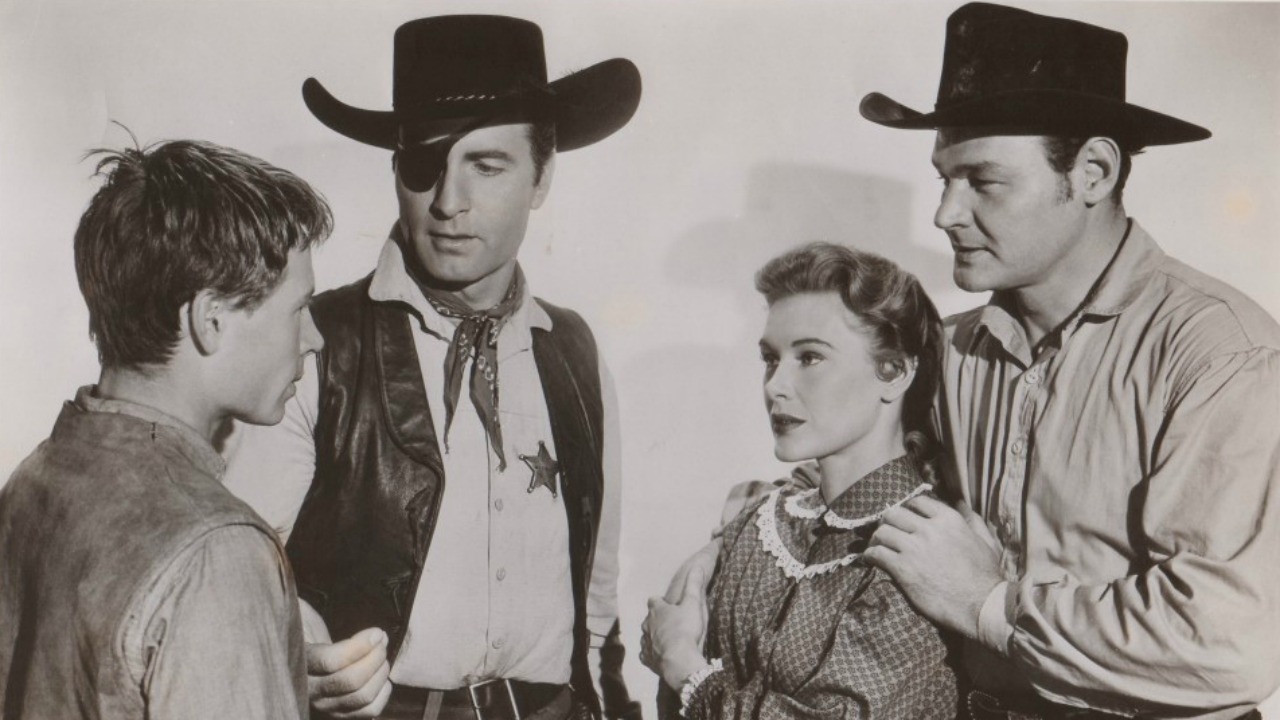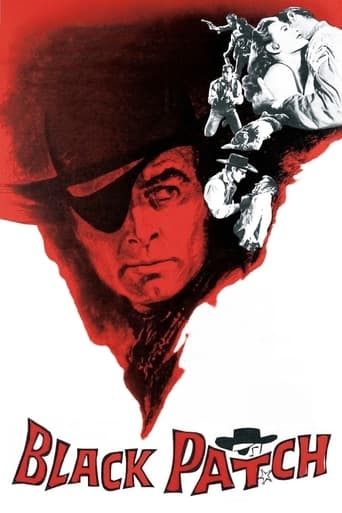

That was an excellent one.
... View MoreThis is a small, humorous movie in some ways, but it has a huge heart. What a nice experience.
... View MoreThere is, somehow, an interesting story here, as well as some good acting. There are also some good scenes
... View MoreGreat example of an old-fashioned, pure-at-heart escapist event movie that doesn't pretend to be anything that it's not and has boat loads of fun being its own ludicrous self.
... View MoreA Montgomery Production, released through Warner Bros. (A Televista DVD).Copyright 1957 by Montgomery Productions. U.S. release: 14 September 1957. New York opening on a double bill with Stakeout on Dope Street at RKO neighborhood cinemas: 23 April 1958. U.K. release: 13 April 1958. Australian release: 1 May 1958. 85 minutes.SYNOPSIS: Montgomery plays a U.S. marshal, wrongly accused of shooting his best friend in the back in order to pinch his wife and his stolen loot. Facing the scorn of the town and the barrel of a gun-crazy avenger, Montgomery...COMMENT: Let me say at once that action fans should give this one a miss. The script - by actor Leo Gordon himself - eschews action. Not only has all the excitement at the beginning of the story occurred before the film commences, but the movie actually comes to a finish before the final showdown. This said, there is much in the picture to interest connoisseurs - not the least of which is Miner's clever direction. The movie's strongest quality, however, is its unusual atmosphere - a mood that is conveyed as much by its well-off-the-beaten-track storyline as by its ingenious music score, using a player piano and a spinet, plus skillfully attuned art direction (I love the marshal's squeaky chair). Acting is perfectly in accord with the mood of the script. Some wonderful character studies really impress, particularly from John O'Malley and Stanley Adams. The sparse black-and-white photography, the carefully judged film editing and excellent sound recording are also considerable assets. In all, a most striking and off-beat western.OTHER VIEWS: The trouble with this film is that it worships unusualness for its own sake. Why does the hero wear a black patch? Why do two out of three of the plot's dramatic climaxes take place off-screen? The answer seems to me that the film's producers just didn't know when to stop and take stock. Whilst it's commendable in principle to get well away from the familiar clichés and conventions of the standard "B" western yarn, this picture is allowed to run right off the rails. A pity, because there are many fascinating things in it - JHR writing as George Addison.
... View MoreAn offbeat Western. Scripted by Gordon, who also takes the role of the friend turned bankrobber that marshal Montgomery is accused of murdering for the Money, Black Patch is directed with verve by Miner, a protégé of Robert Aldrich. Pittman contributes a distinctly modern interpretation of his role as the distraught teenager who faces up to Montgomery at the climax.Phil Hardy
... View More"Ghost Town" director Allen H. Minor's "Black Patch" doesn't qualify your typical 1950s western. This George Montgomery oater unfolds like most, but it concludes with an unusual ending. Comparably, the ending of "Black Patch" anticipated the ending of the 1970s' Burt Lancaster sagebrusher "Valdez is Coming" where everything was left hanging as everybody prepared to shoot it out. Of course, the outcome was clearly predictable, and this was why the scene wasn't played out in its entirety. Similarly, "Black Patch" withdraws before the heroic Montgomery stomps off to deliver the comeuppance to the perfidious villains. Interestingly enough, Sebastian Cabot plays chief villain Frenchy De'vere, with help from his right hand man House Peters, Jr. After convicted bank robber Leo V. Gordon pulled a stretch in San Quentin, he became a scenarist as well as one of the most formidable heavies in Hollywood. Gordon was probably the most menacing villains in 1950s. He penned the above-average script here that casts the rugged Montgomery as a town lawman with one eye, justifying the title "Black Patch." Most of "Black Patch" occurs in the town with an occasional scene in the wilderness. Marshal Clay 'Patch' Morgan (George Montgomery of "Masterson of Kansas") has no patience for drifters. Indeed, he runs them out of Santa Rita in short order. One day, however, an old friend, Hank Danner (Leo V. Gordon of "Riot in Cell Block 13"), rides into town to rendezvous with his new wife, Helen Danner (Diane Brewster), and introduce her to Patch. Things start to stink. Apparently, Patch and Helen were once a romantic item. You have to wonder what kind of a friend Hank is since he all but rubs Patch's nose in the fact that he has married the woman that once loved Patch. Not long afterward, Patch learns that Hank may have been a bank robber. Two lawmen ride into Santa Rita, and they accuse Hank of robbing a bank. Sheriff Ben Maxton (Ted Jacques of "Powder River Rustlers") and Deputy Pete Walker (Strother Martin of "Cool Hand Luke") inform Clay that a lone gunman absconded with over $40-thousand from the Clinton Bank the day before yesterday. Since the robbery, Maxton has organized a half a dozen posses covering every road running for fifty miles out of town. They last saw the robber traveling north. "This fella's a real slick one," Sheriff Maxton explains. "Now, he might have doubled back and figured we might have scattered north." As it turns out, Deputy Walker witnessed the robbery, and he gives a description that fits Hank Danner. "Well, he's a big fella, dressed rough, in black, and he came in as nice as you please. But before we could blink, he had the drop on us." Patch and the Clinton lawmen head for the hotel, but Hank surprises them. "Better put it down, Hank," Patch warns him. "You'll never make it." Hank dismisses any chance of escape and surrenders his six-gun to Patch. Reluctantly, Patch locks Hank in his upstairs jail, but Hank has a six-gun smuggled into his cell by a drunken gunman, Holman (House Peters, Jr. of "Rio Conchos"), who serves as the right hand to slimy, bar owner Frenchy De'vere (Sebastian Cabot) who has no love lost for Patch. They give him the gun in exchange for $20-thousand, but Frenchy soaks the bullets in champagne so they won't discharge. Holman rides out to where we first saw Hank and digs up the loot. Later, Hank forces Patch to open his cell and a rough and tumble fistfight ensues. Hank scrambles out of the jail, but the treacherous Holman shoots him twice in the back. When he comes barreling out of his office, Patch blasts away twice at the fleeing figure of Holman as the drunkard lurches into the ally. Everybody believes that Patch shot Hank in the back, and Karl (Tom Pittman) who cleans Patch's rifles when he isn't killing flies at the hotel turns against him. Helen wants nothing to do with Patch, and she gives Hank's gun and gunbelt to Karl. The change that Karl goes through is pretty conspicuous. He is transformed into an arrogant gunslinger, and he shoots rather well considering that he hasn't had Hank's Colt revolver for long. He turns against Patch, but ultimately they become friends again after Patch refuses to shoot it out with him.The casting of Leo V. Gordon as an initially good citizen is unusual. Look for Dan Blocker as a blacksmith and Robert Mitchum's brother John as a gambler. "Black Patch" isn't a landmark western, but it offbeat enough to watch.
... View MoreGeorge Montgomery starred in several interesting westerns in a career that spanned several decades. This film, scripted by co-star Leo Gordon, was a very interesting change of pace for both.Montgomery plays a one-eyed lawman, who once loved the woman now married to the character played by Leo Gordon. Gordon and Montgomery interact with great chemistry, varying between friendship and jealousy.Leo Gordon was one of the great western villains and a pretty decent writer of scripts. In this film, he steals the show ---- playing a more sympathetic and well-rounded sort of cowpoke.Not a great film, but western fans will like this one.
... View More